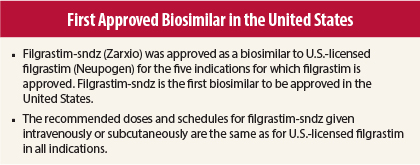In the Clinic provides overviews of novel oncology agents, addressing indications, mechanisms, administration recommendations, safety profiles, and other essential information needed for the appropriate clinical use of these drugs.
On March 6, 2015, the granulocyte colony-stimulating factor filgrastim-sndz (Zarxio) was approved as a biosimilar to U.S.-licensed Neupogen (filgrastim) for the five indications for which filgrastim is approved.1,2 Filgrastim-sndz is the first biosimilar to be approved in the United States. The formulation of filgrastim-sndz differs from that of filgrastim in one inactive component.
The five indications of use consist of (1) to decrease the incidence of infection‚ as manifested by febrile neutropenia‚ in patients with nonmyeloid malignancies receiving myelosuppressive anticancer drugs associated with a significant incidence of severe neutropenia with fever; (2) to reduce the time to neutrophil recovery and duration of fever following induction or consolidation chemotherapy in patients with acute myeloid leukemia (AML); (3) to reduce the duration of neutropenia and neutropenia-related clinical sequelae in patients with nonmyeloid malignancies undergoing myeloablative chemotherapy followed by bone marrow transplantation; (4) to mobilize autologous hematopoietic progenitor cells into the peripheral blood for collection by leukapheresis; and (5) to reduce the incidence and duration of sequelae of severe neutropenia in symptomatic patients with congenital neutropenia‚ cyclic neutropenia‚ or idiopathic neutropenia.
Supporting Data
Approval was based on demonstration that filgrastim-sndz is highly similar to filgrastim in structure and clinical function and activity, with minor differences in clinically inactive components. Filgrastim-sndz has the same amino acid sequence as filgrastim and similar biologic activity and receptor binding, physicochemical properties such as higher-order structure, product-related substances and impurities, and stability profile.
Four studies evaluated subcutaneous doses of 1 to 10 µg/kg of filgrastim-sndz in healthy subjects and compared the pharmacokinetics and pharmacodynamics of filgrastim-sndz with U.S.-licensed filgrastim (one study) or European Union–approved filgrastim (three studies). The 90% confidence interval for area under the concentration-time curve (AUC) and maximum concentration of filgrastim-sndz after a single dose were within the predefined limits of 80% to 125%. The 95% confidence interval for area under the effect curve (AUEC) for absolute neutrophil count and maximum absolute neutrophil count after a single dose were within the predefined limits of 80% to 125%, and the 95% confidence interval for AUEC and maximum count for CD34-positive cell counts after multiple doses were within the 80% to 125% limits.
How It Is Given
The recommended doses and schedules for filgrastim-sndz given intravenously or subcutaneously are the same as for U.S.-licensed filgrastim in all indications—ie, in the settings of patients with cancer receiving myelosuppressive chemotherapy or induction and/or consolidation chemotherapy for AML, patients with cancer undergoing bone marrow transplantation, patients undergoing autologous peripheral blood progenitor cell collection and therapy, and patients with congenital, cyclic, or idiopathic neutropenia.
Safety Profile
Safety data for filgrastim-sndz were evaluated in 204 healthy subjects and 214 patients with breast cancer. The safety profile was similar to that of the U.S.-licensed or European Union–approved filgrastim.
Filgrastim-sndz carries warnings/precautions for fatal splenic rupture, acute respiratory distress syndrome, serious allergic reactions (including anaphylaxis), and fatal sickle cell crises. Filgrastim-sndz is contraindicated in patients with a history of serious allergic reactions to human granulocyte colony-stimulating factors such as filgrastim or pegfilgrastim products. ■
References
1. U.S. Food and Drug Administration: Filgrastim-sndz. Available at www.fda.gov/Drugs/InformationOnDrugs/ApprovedDrugs/ucm436953.htm. Accessed March 23, 2015.
2. Zarxio (filgrastim-sndz) injection prescribing information, Sandoz Inc, March 2015. Available at www.accessdata.fda.gov/drugsatfda_docs/label/2015/125553lbl.pdf. Accessed March 23, 2015.
Report Adverse Events
Health-care professionals should report all serious adverse events suspected to be associated with the use of any medicine or device to FDA’s MedWatch Reporting System by completing a form online at http://www.fda.gov/medwatch/report.htm, by faxing (1-800-FDA-0178), by mailing the postage-paid address form provided online, or by telephone (1-800-FDA-1088).


